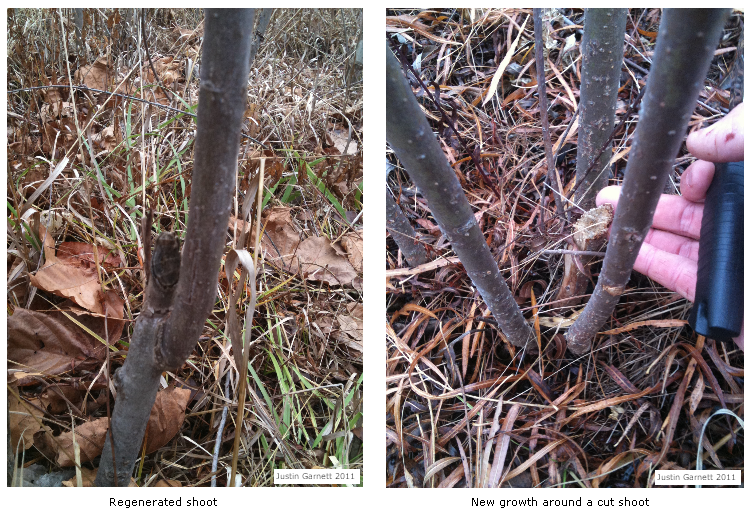Justin Garnett, 2011
If you’ve ever tried to collect wood shoots for making darts, you know that you’ll pass by a lot of rejects for every acceptable shoot. A good strategy for improving the quality and quantity of uniform, straight shoots is coppicing. Coppicing is the process of cutting back established trees to stimulate new growth. The tree is like the Hydra of classical myth; for every head removed, more will sprout. The reason for this it that the actively growing tips (Called the apical meristem) generates a chemical (Auxin) as it grows. The Auxin is carried throughout the tree and serves to maintain what is called “Apical dominance”, that is, the ability of the apex or “leader” shoot to grow taller and faster than other branches. Removing the apical meristem interrupts this chemical signal, and the myriad of other shoots and buds lower on the tree no longer receive the signal not to grow. Lucky us!
Cut the shoots down with a very sharp knife or saw. It’s best not to cut straight across-make downward slanting cuts. This will allow rainwater to run off, letting the cut stumps dry faster and lesseneing the chance of infection or disease entering the living tissues of the stump. Hot wax or commercial tree-wound treatment can be applied to the wound if desired, but this is not necessary.
As you might imagine, removing the apical meristem and it’s auxin signal releases all the buds on the lower stem to begin growth, resulting in a “Crown” of shoots emerging from the cut stump. And, perhaps best of all, these shoots will now grow at about the same rate. What this means is when you locate (Or propagate) a good stand of willow, the act of removing dart shafts will encourage the production of more and more uniform dart shafts. A routinely harvested patch is best. It’s also best not to cut down all the shoots in an area, as the surrounding branches will cause the new shoots to elongate taller faster to compete with their neighbors for light. I have a favorite patch I cut from a couple of times a year. Further, the larger the established tree is, the faster the new shoots will spring back. It’s not unusual to have shoots over 8 feet tall bounce back in a single growing season. This is because the larger the tree is, the more carbohydrate reserves (“Food”) it has built up in it’s root mass. It has the ability to “Feed” the growing shoots much more energy than they could get from the sun alone.
Another great situation is one where a willow stand lies along a highway or roadside. These will be chopped, mowed and brushhogged periodically (Every couple of years) by roadcrews. The result is the same as an intentional coppice-lots of tall, straight, uniform diameter shoots will spring back in a season. These unintentional “Roadside coppices” are excellent sources of dart material as well, but there’s just something sort of magical about returning to “your” willow stand, locating the cut stump from which you made a dart the year before, and cutting another one or two from the same stump. It’s a feeling of being part of a cycle, one which has been going on for untold thousands of years since humans first noticed new shoots sprung up plentifully upon cut stumps.



